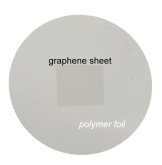NU -TEGRAM : Nanofluidics and Ultrafiltration with Track Etched Graphene -Polymer- Composite Membranes

Abstract
Membranes can be used in a plethora of applications. As permeation-selective barrier they may serve as a separation membrane, for e.g., ultrafiltration, dialysis, water purification, or gas separation.
In a more general context, they can also be used as a chemical, physical, or electrical barrier, e.g., in protective films, capacitors, or as sensors.
For all these applications it is advantageous to make the membrane as thin as possible and at the same time as mechanically and chemically robust as possible. With respect to these criteria, graphene seems to represent the ideal material due to its mechanical strength and infinitesimal thickness of only 3 Å. Perfect graphene is impermeable for all gases and liquids and perforated graphene promises an unprecedent ed level of transport rates in filtering applications as the quasi two-dimensional selective membrane would exhibit negligible wall interactions.
Thus, for membrane technologies novel composites based on graphene can offer significant improvements unachiev able by conventional materials.
The main goals of this proposal are the following:
We aim to develop a process for the manufacturing of robust composites consisting of graphene and a polymer film, which will be processed further to produce ultrafiltration(UF) or nanofiltration (NF) membranes with relevance for technical separations, where the selective element is a single, artificially perforated layer of graphene.
The performance of these UF and NF membranes will be assessed and the underlying mechanisms of manufacturing and separation processes will be elucidated.
The perforation of the composite will be achieved by an established technology, i.e. the irradiation with swift heavy ions, enabling to control pore density and size in graphene. These pores will have a very narrow size distribution (isoporous) and their size can be selected in the range from 5 to 50 nm² thus offering a high degree of selectivity.
By using another established technology known as “track-etching”, the selective barrier pores will be connected to larger pores in the supporting polymer film, yielding a unique composite UF or NF membrane.
Functionalization of the pore entrance, in particular with charged groups, can be used to further increase selectivity so that even desalination of water may be feasible. As the transport through the 2D barrier layer is not hindered by wall interactions very low pressures are needed.
It is therefore expected that the targeted membrane prototypes for UF or NF will outperform current materials by a factor of ~100 (in terms of higher fluxes at same selectivity) which would enable substantial energy savings.
However, appropriate concepts for integration of such high flux membranes into modules are also absolutely necessary and therefore in this project micro-/nanofluidic separation systems based on graphene will be designed and investigated as first steps towards implementation of such radically novel membranes.
